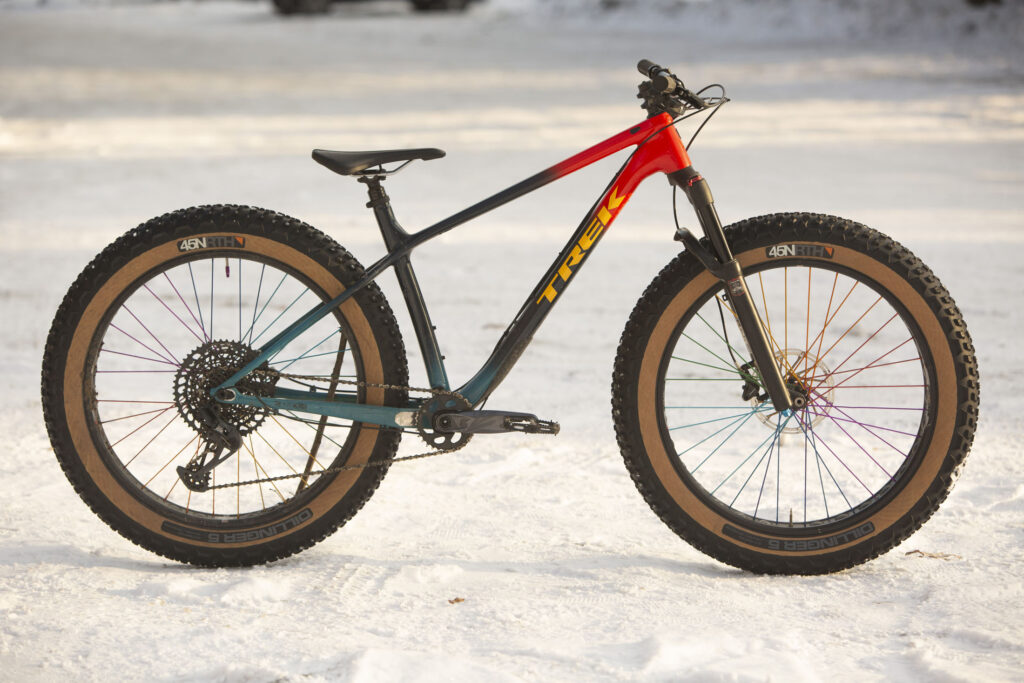The Trek Farley 9.6 is Trek’s top-end carbon fatbike, sporting a full carbon frame, and some workhorse components. I was pleasantly surprised when I jumped on the Farley last season and quickly found it to be my favorite fatbike to date…but not for the reasons I would have thought. My affinity for this bike speaks volumes, as my vintage has allowed me to experience the entire spectrum of fatbikes from inception to current. Starting with the primitive Pugsley days (still love me some classic Pugs!), to the revolutionary float of the Moonlander, to the nouveau geo’ of the Xprezo Gros-Big (RIP), I’ve learned a lot in my time about cycling on snow.


Before we jump in I’d like to relay some hard-earned lessons:
- 4.6” x 26” tires on 90mm rims is PLENTY of fat, and plenty of float.
- Studs are the shit. If you have to ask if studs are necessary for any given ride, you should have them.
- Geometry is critical; low standover height for the win! Head tube angles should not be reminiscent of 1990’s MTB nor should they employ enduro-bro angles.
- Chainstays should be long enough to accommodate quality climbing in snow, not so short you hockey-stop in corners.
- And yes, dropper posts aaaaaand front suspension are an oh-so-sweet luxury worth the expense!
I’ve developed a grand appreciation for my Trek Farley and its shiny bits that make the other nerds’ pants tight. Aside from a stellar aesthetic (subjective, I know), it is high functioning. And function, regardless of fashion, is critical in fatbiking. All those aforementioned lessons are paying off in real time aboard the Farley.




Think of it this way: in any winter cycling pursuit, everything is working against you. Snow is soft… unless it is not and the trails are blue ribbons of death ice. Snow smooths out into primo 12” wide cold-rolled-coasters-o-bliss that command putting the hammer down… until you deviate 2” and lodge your front wheel in 12” of ejection-seat pow. So, in my experience, the very best we can do is aim for the all-around-function median!
The quality I appreciate most in the Farley is its “normalness”; Call them generic characteristics if you will. Beyond colorways, the bike pretty much hasn’t changed much since 2016 (27.5” wheels being an exception). The Farley boasts geo’ numbers that are in the happy medium, meaning it’s optimized for versatility, and not trying to be something it’s not. The 69º head tube angle is relatively XCish, which enables the bike to climb well, track decently, and descend comfortably. The 71.5º seat tube angle is again, rather average. It’s upright, putting you in a lovely centered position between the wheels, maximizing buoyancy and balance in soft snow and lending to an efficient seated pedaling position. On paper this all sounds rather milquetoast, right? That’s my point, the bike is pointedly normal and predictably efficient… and fun!




All of this “normal” equates to a great ride quality. We’ve had manic winter conditions so far this season and the bike has performed amazingly well overall. I attribute a lot of this to my Farley’s cockpit proportions. I’m 5’10” and riding a size large with 780mm bars and a 45mm stem. The upright and squared body positioning makes for amazing stability and balance. Again, high functioning, nothing extreme.
In regard to build, my Farley is a custom build comprised of stock parts and past-bike-greatest-hits. I’m pretty psyched with the end output and cost. I’ve been running the I9 Big Rig alloy wheelset for a few years and carried this over to the Farely. Per everything Industry Nine, they are great hubs and wheels, with plenty of flash. One of the best purchases of the season has been a set of studded 45Nrth Dillinger 5 4.5×26” tires. These deserve a glowing review in their own right. To paraphrase, predictable traction for days and they’re the best tires I’ve owned since the ol’ Lou/Lou combo days!

I also had the Ranch Camp Suspension Lab refurbish my Manitou Mastodon Pro, 120mm fork. This is a staple for fatbike suspension and puts other fatbike forks to shame. This season I started running a lower viscosity oil (thank you Professor Scott Miller) meant for low temps. Given the elevated performance, I wish I had been hip to this years ago!
Beyond that, I’ve kept the setup pretty standard and budget conscious:
Brakes: Sram Level TL
Drivetrain: Sram GX Eagle
Saddle: Bontrager Arvada
Stem: Bontrager Line Pro
Bar: Whiskey No. 9 (Carbon)
Wheels: I9 Bigrig 845 / Torch hubs
Tires: 45NRTH Dillinger 5 – 4.6″ studded
Fork: Manitou Mastodon Pro
Seatpost: TranzX dropper
So, overall I’d advocate anyone to get on a Farley. Unless you have a very niche approach to an already niche sport, the Farley is a primo option for fatbike adventures.
Interested in talking to Thibault about building your own Trek Farley? Give him a call at Ranch Camp (802.253.2753) or stop by to chat in person!





I am 62 and my pandemic-origin Farley 9.6 brings out the kid in my old bastard. I’m able to pedal the Lake Erie shores in my neighborhood and stay far enough out in the surf to elude overbearing landowners who insist they own every grain of Beach sand. It scampers over jagged pieces of limestone bedrock with ease. I didn’t know what to expect when I bought it. My main bike for the last few years has been a carbon Trek FX 6 (which I love) but the handling and comfort the Farley offers is beyond compare. If Trek comes up with a carbon Farley e bike, I’ll be first in line to snap it up.
Mark, thanks for taking the time to lend some additional insight to the Farley. Here in Vermont there is snow forecasted by the weekend… Farley season is upon us! Ditto on the Farley ebike!